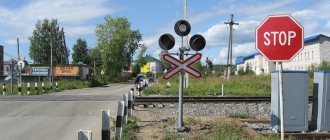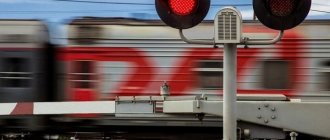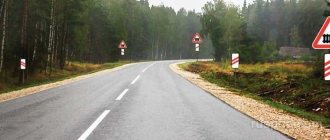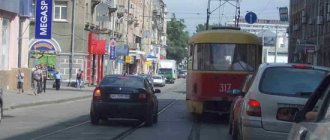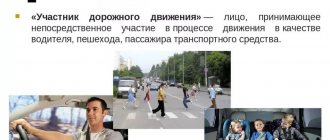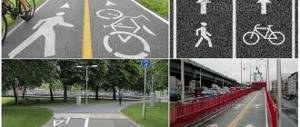What law regulates the rules for crossing railroad crossings?
To ensure an increased level of safety when crossing crossings, a huge number of protective systems are used. However, they are also powerless against reckless drivers or drivers who neglect the simple rules for driving on such sections of the road.
The main legal act, which specifies the main points for the passage of railway tracks, is the Traffic Rules.
Naturally, this topic is given a separate chapter, number 15, in a large set of rules.
Thus, it regulates:
- use of markings, road signs, light signals or a responsible employee;
- situations in the event of which it is strictly prohibited for vehicles to enter the crossing, as well as for pedestrians to enter the crossing;
- the possibility of parking for a long time or stopping for a few minutes for vehicles in the immediate vicinity of the crossing;
- rules that the driver, as well as his passengers, must know and follow in the event of an unexpected stop of the car at the crossing itself.
In the event of an intentional or unintentional violation of the rules prescribed in the traffic rules, the person driving the car is held accountable on the basis of Chapter 12 of the Code of Administrative Offenses of the Russian Federation.
Rail crossing options
In order to master the important rules for traveling railway tracks, you should know that all areas of this type equipped on routes are divided into several categories:
- With the implementation of traffic regulation, that is, regulated.
- Crossings where traffic regulation is not carried out, that is, unregulated.
The first category includes sections where the road intersects with railway tracks, which are equipped with one of the following devices:
- illuminated signs;
- mechanical barrier;
- mechanical fences that perform shockproof function.
This list can also include an employee who is on duty directly at the crossing.
Stop before the railway crossing
0 10435 The railway crossing area is quite dangerous, since trains move there at high speeds, and motorists are constantly in a hurry and even break the rules so as not to stand waiting...
- Read more -
Rules for crossing a controlled railway crossing
As mentioned earlier, any regulated intersection with railway tracks must be equipped with a means of warning or restricting traffic.
When a driver approaches such a section of the road, he is obliged to follow the rules for crossing a railway crossing:
- strictly observe the signals of lighting devices;
- stop in front of a closing or already closed barrier;
- stop driving if the duty officer gives a command to prohibit passage.
When traffic is restricted in any of the possible ways, the driver must stop the vehicle before reaching the painted stop line or near a traffic light. In the absence of any of the options mentioned in the first paragraph - at a distance of no closer than five meters from the lowered barrier.
Rules for crossing an unregulated railway crossing
Movement along a section of road with an unregulated intersection of tracks is carried out on the basis of the following rules:
- When approaching an intersection with railroad tracks, the driver must resort to reducing speed as much as possible.
- Before crossing the tracks, the person driving the car must independently assess the traffic situation and make sure that no train is approaching the crossing.
- It is strictly forbidden to continue moving towards a crossing if there is a traffic jam at it.
When approaching an unregulated intersection with railway tracks and when a train is approaching the intersection at a visible distance, the driver is responsible for stopping the vehicle at a safe distance. Ten or more meters is considered the best option.
Ensuring traffic safety at railway crossings
0 7065 Level crossings are one of the most dangerous areas on the road, as they contain trains that are difficult to stop and cars whose drivers often break the rules when trying to pass through...
— Read more —
Rules for crossing a controlled railway crossing with a barrier
There are two basic and very important safety rules that should be followed when there is a regulated railway crossing with a barrier ahead:
- Stop the vehicle at a distance of at least 5 meters when the barrier begins to lower or is already lowered.
- Continue driving only when the mechanical device is fully raised.
Most of the barriers that are installed in Russia operate automatically. That is, their closure begins from the moment the train crosses the one kilometer mark to the nearest intersection with the highway.
However, it is possible to encounter devices at controlled crossings, the operation of which is the responsibility of the crossing duty officer. It is the person who lowers the barrier when approaching the train crossing.
In both the first and second cases, the driver is strictly prohibited from interfering with the operation of the barrier and independently opening traffic on such a dangerous section of the road. Severe punishment is provided for such actions.
so UNT / Traffic rules / Lesson plans for traffic rules 6th grade
Lesson No. 7 Topic: “Railway crossing. Rules for travel and crossing of the railway"
26.09.2013 36332 0
Goals and objectives of the lesson:
familiarizing students with the basic rules of movement across railway tracks. Formation of safe behavior skills near the railway.
Materials for the lesson:
Look carefully at the picture of the railroad crossing.
Learning new words.
A railroad crossing is a crossing point for railroad tracks.
The barrier is a movable crossbar. If it is lowered, the path is closed; if it is raised, it is open.
The flooring is a wooden sheet on rails, so that when crossing (moving) you do not trip over the rails.
Remember the warning road signs:
Railway crossing Railway crossing with a barrier without a barrier
A railway crossing is the intersection of a road with railway tracks at the same level - this is how this term is interpreted in the Rules of the Road. This is the most dangerous intersection on the driver's route. Collisions at a crossing between a train and a vehicle cannot be compared with traffic accidents at intersections in terms of the severity of the consequences: as a rule, they end in the deaths of road users. The increased danger of railway crossings is associated with the high speed of trains, their weight, which reaches 2-3 thousand tons, and, as a consequence, a long braking distance. The speed of the train exceeds 100 km/h, while the braking distance of the train exceeds 1 km, i.e. The driver is absolutely deprived of the opportunity to prevent a collision. It is no coincidence that back in 1909, the International Convention on Road Traffic adopted the “Railway Intersection” sign among the first four road signs. And currently there are 4 railway crossing signs, which emphasizes the importance of road signs for safe railway traffic.
There are guarded and unguarded railway crossings, in front of which warning signs are installed: “Railway crossing with a barrier” or “Railway crossing without a barrier”. The first such sign is installed 150-300 m ahead, the second - no less than 50 m. Along with these signs, additionally placed on the left and right sides of the road are signs “Approaching a railway crossing. The sign “Railway crossing without a barrier” warns of great danger, since At such a crossing, safety depends only on the driver: there is no barrier, no light alarm, or a person on duty to regulate traffic. Before such a crossing, “Single-track railway” or “Multi-track railway” signs are additionally installed.
To allow a train to pass, the driver must stop 5 m before the barrier closes, and if there is no barrier, 10 m before the first rail. The rules provide for this 5 m for the placement of special vehicles. If vehicles are standing close to a closed barrier, then special vehicles will be forced to move into oncoming traffic, and this can lead to congestion at the crossing. If there are no markings in front of the crossing that determine the number of lanes, or there is no sign “Direction of traffic by lanes”, then the movement of vehicles through the crossing is allowed only in one row. It is prohibited to enter the crossing with a closed or closing barrier (regardless of the traffic light signal), with a prohibitory traffic light signal (regardless of the position and presence of the barrier), with a prohibitory signal from the crossing officer (standing with his chest or back to the drivers with a raised baton, red flag or flashlight), if there is a traffic jam behind the crossing that will force the driver to stop at the crossing, and also if a train is approaching the crossing within sight. In addition, it is prohibited to drive into oncoming traffic when passing, or to open the barrier without permission. In case of a forced stop at a crossing, the driver is obliged to unload people and take all measures to clear the crossing. If the vehicle cannot be removed from the crossing, then the driver is obliged, if there are two people to give a signal to stop the train, to send them in both directions from the crossing at a distance of 1 km, and to remain near the vehicle and give a general alarm signal: one long and three short sound signals. This signal is addressed to other drivers and pedestrians asking for assistance. Those sent ahead must give a signal to stop the train (circular movement with the hand): during the day - with a bright flap or other clearly visible object, and at night - with a torch or lantern. When a train appears, the driver must run towards him, giving a stop signal.
Without permission from the head of the railway station, it is prohibited to move through the crossing road trains whose length exceeds 20 m, special vehicles transporting particularly heavy loads (for example, bridge trusses), low-speed machines and mechanisms whose speed is less than 8 km/h, as well as tractor sleighs -volokush. Agricultural, road, and construction vehicles and mechanisms must move through the crossing in the transport (non-working) position so as not to damage the flooring or crossing equipment. Railway tracks should only be crossed at equipped crossings. Outside the crossing, crossing paths is prohibited.
PEDESTRIAN SAFETY RULES
1. Pedestrians must cross railway tracks only in designated places, using pedestrian bridges, tunnels, and crossings. On pages where there are no bridges or tunnels, citizens must cross railway tracks on decks, as well as in places where “crossing the tracks” signs are installed.
2. Before crossing the path on the pedestrian deck, you must make sure that there is no moving train, locomotive or cars.
3. When a train, locomotive or cars approaches, you should stop, let them pass and, after making sure that there is no rolling stock on adjacent tracks, continue crossing.
4. When approaching a railway crossing, citizens must carefully monitor the light and sound alarms, as well as the position of the barrier. You can cross the tracks only if the barrier is open, and if it is not there, before crossing the tracks, you need to make sure that a train, locomotive or carriage is not approaching the crossing.
PROHIBITED:
1. Walk along the railroad tracks.
2. Cross or run across railway tracks in front of a nearby train, if the distance to it is less than 400 meters.
3. We cross the track immediately after the passage of a train in one direction, without making sure that there is no train in the opposite direction.
4. Cross railway crossings when the barrier is closed or the crossing signal is showing a red traffic light.
5. At stations and stages, crawl under the cars and climb over the automatic couplers to cross the track.
6. Walk along the railway track closer than 5 meters from the outermost rail.
7. Walk across railway bridges and tunnels that are not equipped with paths for pedestrians.
8. Climb under a closed barrier at a railway crossing, and also go out to the crossing when the barrier begins to close.
9. On electrified sections, climb onto supports and also touch the slopes running from the support to the rail.
10. Approach an electrical wire lying on the ground at a distance closer than 8 meters.
PASSENGER SAFETY RULES
1. Boarding (disembarking) into cars should be done only after the train has completely stopped.
2. Exiting and boarding cars must be done only from the side of the platform or boarding platform. Young children should be held by the hand or in arms.
PROHIBITED:
1. Drive on the roofs, steps, and transition platforms of cars.
2. Boarding and disembarking while the train is moving.
3. Lean out of carriage windows and vestibule doors while the train is moving.
4. Stand on steps and transition platforms, open carriage doors while the train is moving, delay the opening and closing of automatic doors of commuter trains.
5. Travel on freight trains without special permission.
6. Travel on trains while drunk.
7. Leave children unattended on boarding platforms and in carriages.
8. Carry flammable and explosive substances in carriages.
9. Get out of the car at the intertrack and stand there as an oncoming train passes.
10. Jump from the platform onto the train tracks.
11. Arrange various outdoor games on the platform.
12. Smoking in carriages (including vestibules) of commuter trains, outside designated smoking areas on local and long-distance trains.
13. Run along the platform next to the carriage of an arriving or departing train, and also be closer than two meters from the edge of the platform while the train is passing without stopping.
14. Approach the carriage until the train stops completely.
15. Unnecessarily stop the train without permission.
Questions for consolidation:
1. Under what circumstances is it prohibited to cross railway tracks?
2. On which sections of the railway is pedestrian traffic prohibited?
3. What are the most common mistakes made by your peers who often have to cross railroad tracks?
4. List the basic rules for crossing railway crossings.
Fines for violating railway rules
Any violation of traffic rules entails liability. In the situation under consideration, when the rules of movement across railway tracks are violated, attention should be paid to the sanctions of article No. 12.10 of the Code of Administrative Offenses of Russia.
It is she, or rather its first part, that states that the recovery of an amount of one thousand rubles from the violator at the expense of the state is threatened for:
- passage of a section of railway tracks in the absence of an equipped special place for this purpose,
- crossing such a section of the road with a mechanical barrier lowered or starting to lower,
- when the prohibiting signal is on on the lighting device,
- the duty officer signals a traffic ban,
- the car parks or stops directly on the railway tracks.
The same action may well be classified by traffic inspectors as a particularly malicious violation of law and order.
In this case, the culprit will be deprived of his driver’s license for a period of one quarter to six months. As you can see, violations of this kind are punished very strictly. For this reason, even when moving along a road located far from federal highways, but with an intersection where railroad tracks cross an ordinary gravel road, it is better to strictly follow the rules. Perhaps, somewhere nearby there is a crew of traffic police officers who will immediately punish the offender.
Speaking of the problem, when a driver allows a car to leave a crossing that a train is approaching, or when behind such a section of the road there is an obstacle to further movement - a traffic jam, then one should expect penalties provided for in Part 2 of Article 12.10 of the Code of Administrative Offenses of the Russian Federation.
Violations of the rules for traveling railway tracks, with the exception of those situations described in the first part, entail a penalty equal to one thousand rubles.
If the violator does not heed the requirements of the law and is caught committing a repeated offense that falls within the scope of this article, he may be subject to an unalternative punishment in the form of a one-year deprivation of his driver's license.
